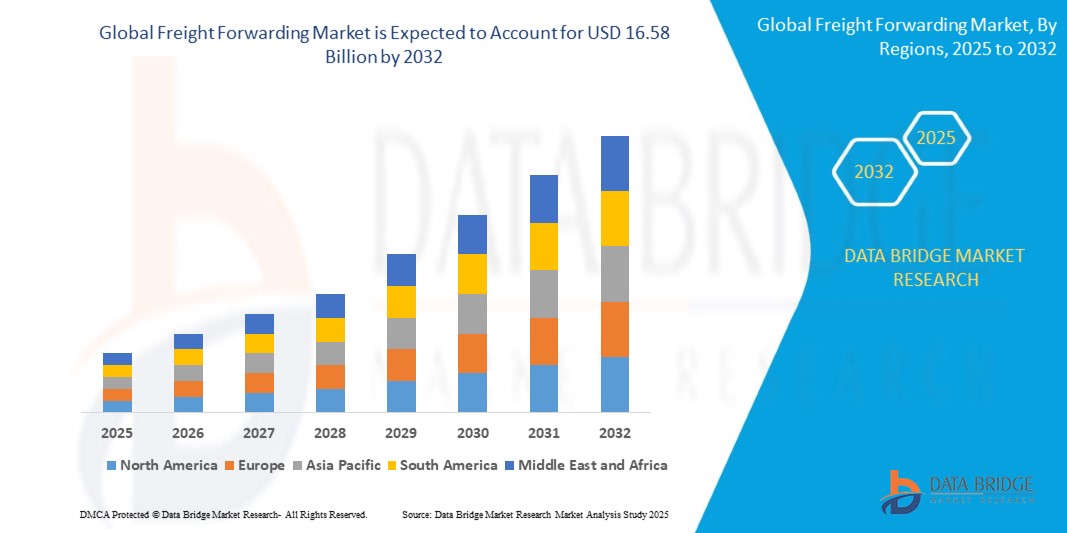Introduction
The Freight Forwarding Market is an essential component of global trade, responsible for coordinating the movement of goods across borders and supply chains. With increasing globalization, international trade growth, and technological advancements in logistics, the demand for efficient freight forwarding services is rising.
Freight forwarding companies act as intermediaries between shippers and transportation services, ensuring that goods reach their destination efficiently and cost-effectively. As global trade expands, so does the need for advanced freight forwarding solutions to handle complex logistics, customs clearance, and regulatory compliance.
In this article, we will explore the key trends, challenges, and future opportunities in the freight forwarding market.
Understanding Freight Forwarding
What is Freight Forwarding?
Freight forwarding is the process of organizing and managing the shipment of goods from one location to another, typically across international borders. Freight forwarders handle logistics, documentation, and coordination with carriers to ensure smooth transportation.
Key Functions of a Freight Forwarder
Freight forwarders offer various services, including:
- Cargo Booking: Arranging transport via air, sea, rail, or road.
- Customs Clearance: Handling import/export regulations and documentation.
- Warehousing and Storage: Managing temporary storage solutions.
- Risk Management: Insuring shipments against damage or loss.
- Freight Consolidation: Combining multiple shipments to reduce costs.
Types of Freight Forwarding Services
- Air Freight Forwarding: Fast and efficient, commonly used for high-value or time-sensitive goods.
- Sea Freight Forwarding: Cost-effective for large shipments and international trade.
- Road Freight Forwarding: Essential for domestic and regional logistics.
- Rail Freight Forwarding: A reliable option for bulk goods and intercontinental trade.
Market Size and Growth Analysis
Global Freight Forwarding Market Overview
The freight forwarding market is experiencing rapid growth due to the rise of e-commerce, expanding international trade, and increasing supply chain complexity. The global market is projected to grow at a CAGR of over 5% in the coming years.
Market Size by Region
- North America: Strong logistics infrastructure and high demand for express shipping.
- Europe: Growth driven by cross-border trade and industrial manufacturing.
- Asia-Pacific: Rapidly expanding market due to China’s trade dominance and manufacturing hubs.
- Rest of the World: Emerging markets in Africa and the Middle East are showing gradual growth.
Growth Drivers and Market Trends
- E-Commerce Boom: More online sales require efficient freight solutions.
- Technological Advancements: AI, IoT, and digital platforms are revolutionizing freight management.
- Global Supply Chain Expansion: Increased demand for cross-border trade facilitation.
Key Players in the Freight Forwarding Industry
Several global companies dominate the freight forwarding industry, offering end-to-end logistics solutions. Some of the leading players include:
- DHL Global Forwarding
- Kuehne + Nagel
- DB Schenker
- Expeditors International
- UPS Supply Chain Solutions
These companies invest heavily in technology, automation, and sustainability to stay competitive in the evolving logistics landscape.
Market Segmentation
By Mode of Transportation
- Air Freight
- Sea Freight
- Rail Freight
- Road Freight
By Service Type
- Freight Transport
- Warehousing and Storage
- Customs Brokerage
By End-User Industry
- Retail and E-Commerce
- Automotive
- Manufacturing
- Healthcare and Pharmaceuticals
Factors Driving Market Growth
Growth in E-Commerce and Global Trade
The explosion of e-commerce has significantly boosted the demand for efficient freight forwarding services. Online shopping platforms require fast and reliable shipping solutions to deliver goods across borders. With millions of daily shipments, logistics companies are expanding their freight forwarding operations to meet increasing demand.
Additionally, globalization has led to an increase in international trade. Countries rely on freight forwarding services to ensure smooth import and export processes, making freight forwarders a crucial part of global supply chains.
Advancements in Digital Freight Technology
Technology is transforming the freight forwarding industry, making it more efficient and cost-effective. Key technological advancements include:
- AI and Machine Learning: Used for route optimization and demand forecasting.
- IoT-Enabled Tracking: Provides real-time visibility of shipments.
- Blockchain for Supply Chain Transparency: Enhances security and efficiency in documentation and payments.
Demand for Cost-Effective and Efficient Logistics Solutions
Businesses are looking for ways to cut logistics costs while improving efficiency. Freight forwarding companies are responding by offering consolidated shipments, optimized routes, and digital freight platforms that reduce expenses and streamline operations.
Challenges and Market Restraints
High Shipping Costs and Fuel Price Volatility
The cost of shipping has been rising due to fluctuating fuel prices, increasing labor costs, and port congestion. These factors make freight forwarding more expensive, impacting profit margins for both service providers and customers.
Supply Chain Disruptions and Port Congestions
Recent global crises, including the COVID-19 pandemic, geopolitical tensions, and natural disasters, have caused major disruptions in supply chains. Delays in shipping, port congestion, and container shortages have become significant challenges for freight forwarders.
Regulatory and Compliance Challenges
Freight forwarding involves complex regulations, including customs documentation, tariffs, and trade policies that vary by country. Navigating these regulations can be time-consuming and costly for businesses operating in multiple regions.
Regional Insights
North America Freight Forwarding Market
- Strong demand due to extensive logistics networks.
- High e-commerce penetration driving faster shipping solutions.
- Presence of major logistics companies like UPS, FedEx, and DHL.
Europe Market Trends
- Well-established trade routes and logistics infrastructure.
- Increasing focus on sustainable freight solutions.
- Strong regulatory environment affecting market operations.
Asia-Pacific Market Growth Potential
- Rapid industrialization and trade expansion, particularly in China and India.
- High demand for air and sea freight services due to global exports.
- Emerging markets adopting digital freight technologies.
Rest of the World Market Overview
- Latin America and Africa are witnessing steady growth in trade.
- Infrastructure limitations pose challenges to freight forwarding services.
- Investments in logistics technology are improving market conditions.
Role of Technology in Freight Forwarding
Digital Freight Platforms and Automation
Modern freight forwarding is heavily reliant on digital platforms that automate booking, tracking, and documentation processes. These platforms reduce paperwork, enhance efficiency, and provide cost-effective solutions for shippers.
AI and IoT in Freight Management
- AI-powered analytics help predict demand and optimize logistics routes.
- IoT-enabled sensors provide real-time tracking of cargo, improving supply chain visibility.
Blockchain for Secure and Transparent Transactions
Blockchain technology enhances security in freight forwarding by reducing fraud, improving documentation accuracy, and enabling smart contracts for automated payments.
Impact of COVID-19 on the Market
Supply Chain Disruptions and Recovery Trends
The pandemic disrupted global supply chains, causing delays and increased costs. However, the freight forwarding industry has adapted by diversifying supply chain networks and investing in automation.
Post-Pandemic Market Adjustments
- Shift towards regional supply chains to reduce dependency on long-haul shipping.
- Increased investment in digital freight solutions.
Long-Term Impact on Freight Forwarding
The pandemic highlighted the need for more resilient supply chains. Companies are now prioritizing flexibility, risk management, and digital transformation in freight forwarding operations.
Future Trends in the Freight Forwarding Market
Sustainability and Green Logistics
The logistics industry is under pressure to reduce carbon emissions. Freight forwarders are adopting eco-friendly practices such as:
- Using electric and hybrid trucks for transportation.
- Implementing carbon offset programs.
- Optimizing routes to reduce fuel consumption.
AI-Driven Route Optimization and Predictive Analytics
AI-driven logistics systems help freight forwarders:
- Reduce transit times by selecting the fastest and most efficient routes.
- Predict demand fluctuations and optimize supply chain strategies.
Expansion of Freight-as-a-Service (FaaS) Models
Freight-as-a-Service (FaaS) is an emerging business model where businesses pay for freight services on a subscription basis, providing greater flexibility and cost efficiency.
Investment Opportunities and Market Forecast
Growth Potential in Emerging Markets
Countries with developing logistics infrastructure, such as India, Brazil, and Nigeria, present significant investment opportunities for freight forwarding companies looking to expand.
Investment Trends in Freight Technology
- Increased funding for AI-powered freight platforms.
- Expansion of digital freight marketplaces connecting shippers and carriers.
Market Forecast for the Next Decade
The global freight forwarding market is expected to grow at a CAGR of over 5%, driven by digitalization, e-commerce, and the demand for sustainable logistics solutions.
Freight Forwarding and Global Supply Chain
Role of Freight Forwarders in International Trade
Freight forwarders facilitate cross-border trade by managing customs procedures, coordinating shipments, and ensuring compliance with international regulations.
Strategies to Overcome Logistics Challenges
- Diversifying supply chains to reduce dependency on single suppliers.
- Using advanced analytics for predictive demand forecasting.
Importance of Efficient Freight Management
Efficient freight forwarding minimizes costs, reduces delivery times, and enhances supply chain reliability for businesses operating globally.
Consumer Preferences and Industry Shifts
Rising Demand for Fast and Reliable Deliveries
Consumers expect faster shipping times, pushing freight forwarders to invest in express delivery services and optimized logistics networks.
Preference for Sustainable and Cost-Effective Solutions
Businesses are looking for eco-friendly freight options that balance cost efficiency with sustainability goals.
Shifts in Trade Routes and Freight Demand
- The Belt and Road Initiative (BRI) is influencing trade routes between China, Europe, and Africa.
- Growing regional trade agreements are reshaping global supply chains.
Conclusion
The freight forwarding market is experiencing significant growth, driven by globalization, digital transformation, and the increasing complexity of global trade. While challenges such as supply chain disruptions and regulatory issues persist, technological advancements and sustainability initiatives are shaping the future of freight forwarding.
Get More Details : https://www.databridgemarketresearch.com/reports/global-freight-forwarding-market













Leave a Reply